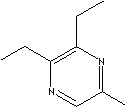| CAS
NO. |
18138-04-0 |

|
| EINECS
NO. |
242-024-6 |
| FORMULA |
C9H14N2 |
| MOL
WT. |
150.23 |
|
H.S.
CODE
|
2933.90 |
|
TOXICITY
|
|
| SYNONYMS |
2,3-Diethyl-5-methyl-1,4-diazine;
2,3-Diethyl-5-methylpyrazine |
|
Terrazome 073;
2,3-Diethyl-5-methyl-p-diazine; |
|
PRICE |
|
|
CLASSIFICATION
|
|
|
PHYSICAL AND CHEMICAL PROPERTIES
|
| PHYSICAL
STATE |
clear to pale yellow liquid |
|
MELTING
POINT
|
|
| BOILING
POINT |
|
| SPECIFIC GRAVITY |
0.950
± 0.05 |
|
SOLUBILITY
IN WATER
|
slightly soluble |
| pH |
|
| VAPOR DENSITY |
|
| AUTOIGNITION |
|
|
REFRACTIVE
INDEX
|
1.497 - 1.502 |
| NFPA RATINGS |
|
| FLASH
POINT |
75
C |
| STABILITY |
Stable under ordinary
conditions |
|
GENERAL
DESCRIPTION & APPLICATIONS
|
|
Pyrazine, hygroscopic white solid, is an aromatic nitrogen compound characterized
by a ring structure contains 4 carbon atoms with two nitrogen atoms at
1 and 4 positions (paradiazine); melting
at 55 - 56 C, boiling at 115 - 116 C. Pyrazine is freely soluble in water.
It is fused to form many polycyclic compounds, as useful structures in pharmaceuticals
and perfumes. It is a component of the folates (vitamin
B compounds) and of the isoalloxazine ring nucleus of
flavins. Numerous pyrazine derivatives such as pyrazine polycyclic compounds,
alkyl-, alicyclic-, and alkylaryl-substituted compounds,
derivatives containing oxygenated functional groups
and thio- functional groups in the side-chains are used in biological, drug,
flavouring
and perfumery industry.
2,3-diethyl-5-methyl-pyrazine
is used as a composition of
flavouring especially in baked property.
Odor
Description : bread crust, nutty |
| SALES
SPECIFICATION |
|
APPEARANCE
|
clear to pale yellow liquid |
| ASSAY
(G.C) |
97.0%
min |
|
SPECIFIC GRAVITY |
0.950
± 0.05 |
| TRANSPORTATION |
| PACKING |
|
| HAZARD CLASS |
not
regulated |
| UN
NO. |
|
| OTHER
INFORMATION |
Hazard Symbols: Risk Phrases: 36/37/38, Safety
Phrases: 24/25
FEMA NO. 3336 |
